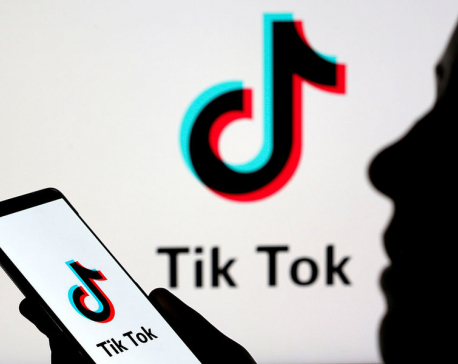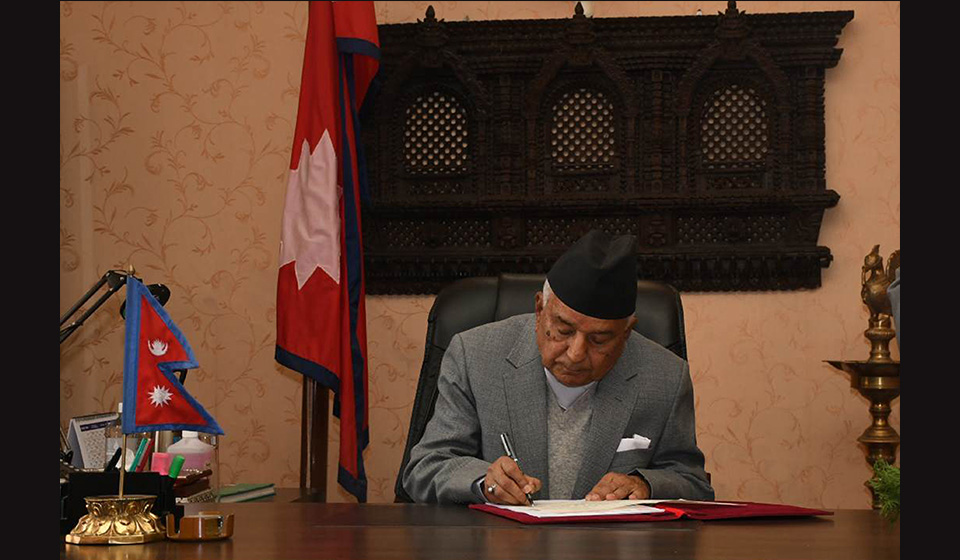
OR
Opinion
Comrades, TikTok is the Giga-factory of the 21st Century
Published On: January 1, 2024 08:47 AM NPT By: Bimal Pratap Shah

The irony deepens as the Communists, once champions of the proletariat, have now assumed characteristics akin to the bourgeoisie.
In the 1990s, Nepal experienced the initial waves of the first industrial revolution when the world was already reaping the benefits of the third industrial revolution. This shift marked prevalent labor exploitation, setting the stage for the Maoist-led People's War, as the democratic government could not promptly enact reforms as the focus of political parties were only on internal power struggles to capture and share state’s resources. The bad governance and Maoist led people’s uprising created unfavorable situations for the factories and services sector to thrive.
On the 22nd of December, 2023, 'The Hindu,' a distinguished news portal, spotlighted a compelling story titled 'Nepali Youth Joining Russian Frontline.' This narrative eloquently unravels the harsh truths surrounding the pressing employment challenges confronting the youth of Nepal. This poignant account serves as a stark reminder of the systemic shortcomings that have led to the unfortunate failure of the Nepalese state. In an era marked by the advancements of the Fourth Industrial Revolution, one must ponder: Why are the vibrant youth of Nepal compelled to navigate such dire straits in pursuit of livelihood and purpose. Let's unpack.
An industrial revolution is driven by novel technologies, frequently giving rise to radical political ideologies that, in turn, ignite substantial transformations in economic and social structures. With four major revolutions witnessed so far, we are currently navigating the fourth. Unfortunately, Nepal has missed the opportunities presented by the first three revolutions and is at risk of overlooking the fourth due to a government’s policies driven by the regressive tyrannical mindset. The most radical innovations, like TikTok and cryptocurrencies, powering the fourth industrial revolution are banned in Nepal. This is like banning steam-powered factories in the 18th century that revolutionized the production of goods, laying the foundation for the First Industrial Revolution.
Simply put, the industrial revolutions are marked by the adoption of new technological innovations that facilitate increased production and mass manufacturing. "The shift from Industry 1.0 to Industry 4.0 symbolizes an ongoing journey of innovation, where each revolution progressively replaces manual labor-intensive manufacturing with ever-advancing levels of automation—a catalyst for global industrialization and sustained economic growth. Industry 4.0 differs from the last three phases in that it focuses on a creative economy, not just improving manufacturing. Regrettably, Nepal finds itself entangled in the web of Industry 4.0 challenges, exacerbated by an outright ban on cryptocurrency and TikTok. This stems from the fact that Nepal's political landscape remains tailored to the era of the First Industrial Revolution.
The first Industrial Revolution, commencing in the 18th century, was driven by the utilization of steam power and the mechanization of production. Traditional spinning wheels, which once produced threads at a limited pace, were revolutionized to achieve eight times the volume in the same time-frame. Steam power, previously known but not extensively applied, became a groundbreaking force for enhancing human productivity as well as allowing for swift and efficient movement of both humans and goods over great distances. Nations that could produce goods ten times faster and more affordably, while efficiently transporting them over long distances in shorter time frames, emerged triumphant in the Industry 1.0 competition. During that period, Nepal endured a stagnant phase under the rule of the Rana Oligarchy and their isolationist policies.
The First Industrial Revolution not only increased manufacturing capacities but also had profound social and political impacts that transformed the fabric of society. As factories emerged, people moved from rural areas to urban centers in search of employment, leading to the rapid growth of cities. This urbanization had significant social implications, including the rise of crowded and often unsanitary living conditions. The industrial workforce also faced challenging conditions, characterized by long working hours, low wages, and unsafe working environments. The lack of labor regulations and workers' rights led to social unrest and the formation of labor movements advocating for better working conditions and fair wages. Class division began to appear as the wealthy industrialists and factory owners formed an affluent capitalist class, while the working class, consisting of laborers and factory workers, experienced economic hardships. This socioeconomic divide fueled class tensions and laid the groundwork for new types of social and political movements.
On one side of the spectrum were bourgeoisie emphasizing individual rights, free markets, and limited government intervention. On the other end, harsh working conditions and labor exploitation led to the formation of labor movements advocating for workers' rights. Trade unions and worker associations emerged to negotiate for better wages, reduced working hours, and improved workplace safety. These movements played a crucial role in shaping labor laws and regulations in the years to come.
Marxism gained traction as a response to the inequalities spawned by industrialization. Karl Marx and Friedrich Engels highlighted the exploitation of the working class by the bourgeoisie. Their ideas resonated with workers facing harsh conditions, leading to the rise of labor movements. Marxism provided a theoretical basis for critiquing societal inequalities and became a rallying point for those advocating for workers' rights in the changing industrial landscape. The social upheavals and demands for change led to political responses.
Governments were forced to introduce labor laws and regulations to address some of the most egregious workplace conditions. These reforms were often influenced by the fear of social unrest and the desire to maintain stability. In the 1990s, Nepal experienced the initial waves of the first industrial revolution when the world was already reaping the benefits of the third industrial revolution. This shift marked prevalent labor exploitation, setting the stage for the Maoist-led People's War, as the democratic government could not promptly enact reforms as the focus of political parties were only on internal power struggles to capture and share state’s resources. The bad governance and Maoist led people’s uprising created unfavorable situations for the factories and services sector to thrive. As a result, people were forced to migrate to the Gulf region in search of factory jobs and opportunities in the services sector. Those with capital migrated to the cities, leading to a chaotic urbanization devoid of any planned design.
In essence, the First Industrial Revolution exerted profound social and political influences, molding history through the shaping of ideologies, catalyzing social movements, and laying the foundation for enduring battles for workers' rights and social justice. These tensions and transformations not only set the stage for subsequent industrial revolutions but also contributed to the evolution of modern political and social structures. The failure to adequately tackle these fundamental socio-economic issues within the democratic framework established after the post-1990 people's movement compelled Nepal to undergo a radical political restructuring in 2006.
The world is currently in the midst of the Fourth Industrial Revolution, commonly referred to as 'Industry 4.0,' symbolizing the seamless integration of information and communication technologies into industrial processes. Industry 4.0 holds the promise of bringing unprecedented advancements within factory environments. Examples range from machines predicting failures and autonomously triggering maintenance to self-organized logistics adapting to unforeseen changes in production. Beyond operational enhancements, Industry 4.0 has the transformative potential to reshape work dynamics, foster smarter networks, and optimize workflows for increased efficiency in manufacturing. Above all, it also involves a significant shift towards a CREATIVE ECONOMY.
This transformation represents a departure from traditional manufacturing to an economy driven by innovation, creativity, and knowledge. In this era, the focus is on harnessing intellectual capital, fostering creativity, and leveraging technology to drive economic growth. Unlike the First Industrial Revolution, which saw the mechanization of production and the rise of factories, the fourth Industrial Revolution emphasizes the importance of ideas, intellectual property, and digital innovation.
The social and political impacts of the Fourth Industrial Revolution are still unfolding, but early trends suggest a move towards a more decentralized and digitally connected world. With the rise of remote work, cryptocurrencies, gig economies, and digital platforms like TikTok, Facebook, and Instagram, there is a redefinition of traditional employment structures. This transition carries implications for labor rights, job security, and the very essence of work. Consequently, it is imperative to confront the challenges linked to the evolving nature of work and guarantee that technological advancements contribute to the overall well-being of society. Notably, remote work has become the new norm.
This new era demands a nimble and adaptive approach to policies and regulations, underscoring the significance of nurturing creativity, championing innovation, and safeguarding the rights of workers in the digital space. For instance, millions of Nepali creators and entrepreneurs have been unable to harness the world's leading platform after the ban. This prohibition has not only stifled their creative expression but also hindered their ability to reach global audiences and tap into the expansive opportunities for growth and collaboration that platforms like TikTok provide and attract foreign currency to the country. The impact resonates beyond individual creators, affecting the overall digital landscape and hindering the country's potential in the global creative economy.
The global creative economy is estimated to be worth around $1.5 trillion, highlighting its importance as a driver of economic growth and employment. International trade in creative goods and services plays a crucial role, with creative services exports reaching nearly $1.1 trillion in 2020 generating millions of jobs worldwide. "As per UNCTAD, the sector employs approximately 31 million people, predominantly from the young demographic, both directly and indirectly.
Developing countries like Nepal have frequently depended on resource-based or low-wage, labor-intensive industries. People are forced to migrate to countries that have booming economies, good governance, competent politicians, progressive regulatory environment, and employment opportunities. Also, landlocked and poorly governed nations, such as Nepal, face challenges in competing with well-governed countries that have access to the sea. However, the creative economy presents an opportunity to diversify economies, tapping into the potential of talent and creativity to generate new revenue streams and export opportunities. Furthermore, creative industries are often knowledge-based and require minimal capital investment, making them accessible to even resource-constrained economies.
The creative economy offers plentiful job opportunities, especially for young people and marginalized groups, fostering micro-entrepreneurship and supporting self-employment contributing to poverty reduction and social inclusion. Creative industries cultivate a culture of innovation and risk-taking, resulting in the development of new products, services, and business models. A thriving creative economy enables developing countries to showcase their unique cultural heritage and traditions globally, fostering national pride, attracting tourism, and promoting cultural exchange.
Just as the old world could not make sense of the first industrial revolution giving rise to new political ideas and transformation. The fourth industrial revolution is also giving rise to new political ideas to navigate this transition. Discussions about universal basic income, the restructuring of school systems, reevaluation of traditional labor structures, have taken center stage. Furthermore, the Fourth Industrial Revolution has sparked debates about privacy, data ownership, and cybersecurity, leading to the formulation of novel policies to protect citizens in the digital realm. The tension between ensuring technological innovation and safeguarding individual rights has become a focal point in political discussions. On the other hand, the Nepalese government is proposing a bill to surveil every citizen without their consent. This appears to be reminiscent of tactics employed by the Stasi. The Stasi, the official state security service and intelligence agency of the German Democratic Republic (Communist East Germany), was notorious for its extensive informant network and its active role in suppressing dissent. Widely regarded as one of the most intrusive and repressive intelligence and secret police agencies in history, the Stasi left an enduring mark on the Cold War era.
Industry 4.0 is also ushering in a new political paradigm, challenging established ideologies and demanding innovative approaches to governance. The ongoing struggle between the old and the new underscores the complexities of navigating a rapidly evolving technological landscape while ensuring that political systems effectively address the needs and concerns of the digital age. Much like how Marxism gained prominence during the first industrial revolution, reshaping the European political structure in the 1900s, the new industrial revolution, powered by the Internet and creatives, has had a significant impact on socio-political conditions as well. In the current system, there is a growing call, especially among the young people, for 'Direct Democracy,' where individuals can vote on laws over the internet.
TikTok serves as a platform for the mass production of content, closely aligning with the analogy to factories. This resemblance is notable in terms of the platform's high volume and efficiency in both content creation and consumption. This evolving paradigm squarely challenges both the Communist regimes and the archaic remnants of the Nepali Congress. As Nepal’s representative democratic governments continue to restrict cutting-edge technologies like TikTok and cryptocurrency, the younger demographic increasingly leans towards endorsing the substitution of representative democracy with a system of direct democracy. The irony deepens as the Communists, once champions of the proletariat, have now assumed characteristics akin to the bourgeoisie.
In short, direct democracy is poised to emerge as the political outcome of the Fourth Industrial Revolution.
You May Like This

Reconsider banning TikTok
In a surprising turn of events, the government announced a ban on the popular social media platform, TikTok, on the... Read More...
_20201014060614.jpg)
Nepal abstains from voting as UNHRC adopts resolution against Sri Lanka's human rights record
KATHMANDU, March 23: Nepal has chosen to abstain from voting in the United Nations Human Rights Council on a resolution... Read More...

Govt should prioritize Miss Nepal: Miss Nepal Shrinkhala Khatiwada
MAKWANPUR, April 24: Newly crowned Miss Nepal World 2018, Shrinkhala Khatiwada has urged the government to prioritize the pageant as... Read More...


Just In
- Ilam-2 and Bajhang 1(a) by-elections: Vote counting begins
- Nepal is a prime destination for international investment: FinMin Pun
- President Paudel issues ordinance related to facilitation of investment
- Hearing on Cricketer Lamichhane’s appeal today
- Nepal Investment Summit (live)
- Clear Policies Set to Boost American Investment in Nepal: US Ambassador Thompson
- Second T-20 series: Nepal loses toss, set to go for fielding first
- Nepal Investment Summit 2024 and Victor Hugo Moments for Reforms







-1200x560-wm_20240427144118.jpg)









Leave A Comment